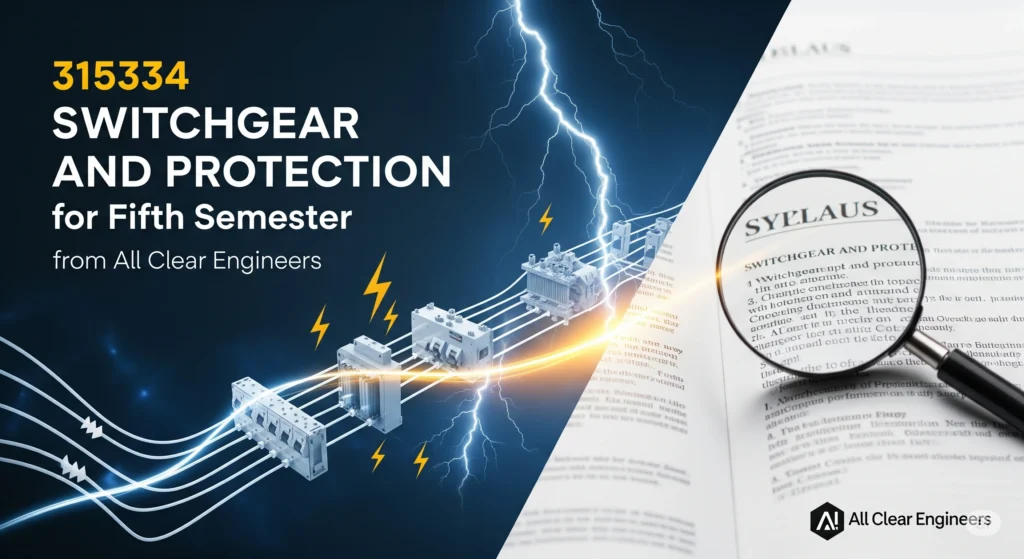Course Title : SWITCHGEAR AND PROTECTION
Course Code : 315334
Semester : Fifth
I. RATIONALE
Switchgear and Protection plays a vital role in maintaining the reliability and stability of the power system. In order to ensure this, operational principles, selection and testing of Switchgear and Protection schemes must be known to the students while performing their duties in electrical sector.
II. INDUSTRY / EMPLOYER EXPECTED OUTCOME
The aim of this course is to help the student to attain the following industry/employer expected outcome through various teaching learning experiences: “Select and use different switchgears and protection schemes to maintain the reliability and stability of the power system”.
III. COURSE LEVEL LEARNING OUTCOMES (COS)
Students will be able to achieve & demonstrate the following COs on completion of course based learning
CO1 – Recognize the different types of faults occuring in power system.
CO2 – Select the suitable switchgears for different applications.
CO3 – Test the performance of different protective relays.
CO4 – Use suitable protection schemes for alternators, motors, transformers, busbars and transmission lines.
CO5 – Select suitable protection schemes for power system against over voltages.
Teaching-Learning & Assessment Scheme
Understanding the structure of the Software Engineering course is crucial for effective learning. Consequently, the following scheme outlines the contact hours, credits, and assessment methods.
| Course Code | Course Title | Abbr | Course Category/s | Learning Scheme | Credits | Assessment Scheme | |||||||||||||
|---|---|---|---|---|---|---|---|---|---|---|---|---|---|---|---|---|---|---|---|
| Actual Contact Hrs./Week | SLH | NLH | Paper Duration | Theory | Based on LL & TL | Based on SL | Total Marks | ||||||||||||
| CL | TL | LL | Practical | FA-TH | SA-TH | Total | FA-PR | SA-PR | SLA | ||||||||||
| 315323 | SOFTWARE ENGINEERING | STE | DSC | 5 | – | 2 | 2 | 9 | 3 | 30 | 70 | 100 | 25# | 10 | 25 | 10 | 25 | 10 | 175 |
Unit – I Fundamentals of Protection
1.1 Protective system: Necessity, functions and components
1.2 Normal and abnormal conditions
1.3 Types of faults and their causes
1.4 Protection zones and backup protection
1.5 Short circuit fault calculations for symmetrical fault on busbars fed through generators
1.6 Current Limiting Reactors : Need, types, arrangements , comparative advantages and disadvantages
Unit – II Circuit Interrupting Devices
2.1 Isolators- Vertical break, Horizontal break and Pantograph type with its advantages and
disadvantages
2.2 HRC fuses – Construction, types, working, Inverse time current characteristics, characteristics of fuse
element, Fuse current rating, Minimum fusing current, Fusing factor, Prospective current, Cut off
Current.
2.3 Terms related to Arc interruption process of fuse – pre-arcing time, cut off value, arcing time, total
operating time, peak of prospective current and applications
2.4 Arc formation process, methods of arc extinction (High resistance and Low resistance).
2.5 Arc voltage, Recovery voltage, Re-striking voltage, Rate of rise of restriking voltage (RRRV).
2.6 HT circuit breakers: Vacuum circuit breaker , Sulphur-hexa Fluoride (SF6) – Working, construction,
specifications and applications
2.7 L.T. circuit breaker: Miniature circuit breakers (MCB ), Moulded case circuit breakers (MCCB), Motor
Protection Circuit Breaker (MPCB) , Residual Current Circuit Breaker (RCCB) and Earth leakage circuit breaker(ELCB), Air circuit breakers (ACB)- Construction, Working and applications
2.8 Selection of LT and HT circuit breakers
2.9 Isolator, fuses and circuit breaker: Comparison
2.10 Gas insulated switchgear
2.11 Insulation Coordination : Type1 & Type2 coordination
2.12 Ring Main Unit Switchgear: Introduction, classification based on: type of insulation (gas, oil, air),
installation (outdoor, indoor).
Unit – III Protective Relays
3.1 Protective Relay: Fundamental quality requirements (Selectivity, Speed, Sensitivity, Reliability, Simplicity, Economy)
3.2 Basic relay terminology- Protective relay, Relay time, Pick up, Reset current, current setting, Plug
setting multiplier, Time setting multiplier.
3.3 Electromagnetic disc relay, Thermal relay, over voltage relay, Over current, Earth fault relay:
Operation and its characteristics.
3.4 Static, Digital Relay (Microprocessor based): Block diagram, working, advantages and limitations. Numerical relay: Introduction
3.5 Distance relaying- Principle
3.6 Directional relay: Need and operation with block diagram.
3.7 Current and Voltage differential relay: Operation
Unit – IV Protection of Alternators, Motors, Transformers, Busbars and Transmission lines
4.1 Abnormalities and Faults occurring in alternator
4.2 Differential, Overcurrent , Earth fault Protection: Schemes
4.3 Reverse power protection: Scheme
4.4 Abnormalities and Faults occurring in transformer
4.5 Differential, over current, earth fault, over heating protection.
4.6 Limitations of differential protection.
4.7 Buchholz relay: Construction, operation.
4.8 Motor: Abnormalities and Faults, Short circuit protection, Overload protection, Single phase preventer.
4.9 Busbar: Faults, busbar protection, differential and fault bus protetion.
4.10 Transmission Line: Faults, Over current, Distance and Pilot wire protection.
Learning Plan Details
| Sr.No/Unit | Unit Title | Aligned COs | Learning Hours | R-Level | U-Level | A-Level | Total Marks |
|---|---|---|---|---|---|---|---|
| 1 | Fundamentals of Protection | CO1 | 8 | 2 | 4 | 6 | 12 |
| 2 | Circuit Interrupting Devices | CO2 | 10 | 2 | 8 | 6 | 16 |
| 3 | Protective Relays | CO3 | 12 | 4 | 4 | 10 | 18 |
| 4 | Protection of Alternators, Motors, Transformers, Busbars and Transmission lines | CO4 | 20 | 2 | 8 | 14 | 24 |
| Grand Total | 50 | 10 | 24 | 36 | 70 | ||




